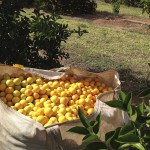Orange Oil CP Brazil Citrus sinensis Harvest: July - December
Markets remain very firm and volatile as we look towards the second half of 2016 although statistically supplies paint a different story.
In January and February, Brazil exported around 90 containers more orange oil than in the same two months of 2015, which continues a trend we saw in the final quarter of 2015. This would suggest supplies have increased at a time when Brazilian producers achieved a premium for their oil. Despite this, the market remains firm and on high alert, as supplies continue to be threatened by the major producers.
It is normal to see supply to the markets fall from June to August, which will be a telling time for how the market gears up for supplies in the second half of 2016. Most major buyers and end-users will be well covered for the next quarter but all indicators from source suggest a similarly difficult second half, just as we’ve seen over the past 12 months.
Average FOB prices are still under today’s market levels as seen in most parts of the world but those numbers continue to be skewed from the conclusion of old contracts. It is expected that when we see average prices from Q2 2016 exports, they will be more inline with today’s market prices.
It is understandable why processors are worried about future supplies. In a normal year around 20% of oranges go into the fresh fruit domestic market. Due to the late blossoming flowers from last year (which produce low yielding fruits unsuitable for processing), it is estimated that this year another 20% will also reach the local market for fresh consumption.
Generally the local markets for fresh fruits peak from February to April so many of these off fruits have been recently picked and sold leaving the available fruits for processing from May onwards very low. This at a time when fruit picking is at its lowest.
Officially Citrus BR closed the 2015/16 season with figures of 261 million orange boxes processed (40.8kg per box). The total of processed and non-processed fruits was calculated to be at 302.2 million boxes for which they summarised as follows:
The juice yield on fruit of 302.2 boxes per metric ton of FCOJ was the worst average ever recorded by the industry. It was 25.7% lower than the 240.5 boxes experienced in the 2014/2015 season. The lower juice yield is the result of the above average rainfalls caused by the El Niño during peak harvesting season. As a result, not only juice content in the fruits has significantly dropped, but average brix of fruits processed have also fallen from 12°Brix in 2014/2015 to 10.2°Brix in 2015/16 season.
Looking ahead to the 2016/17 season the story doesn’t get any better and with it neither do the prospects of more oil availability and price reductions. A Brazilian crop estimate project (PES) looks at the total number of orange bearing trees, average productivity forecasted per bearing tree and estimated total orange production in the state of São Paulo and Minas Gerais Triangle Citrus Belt for the 2016/17 Season.
Today they’re forecasting a sharp reduction of 18.3% in the total 2016/17 crop compared to the one that just closed which will take another 60 million boxes out of the market!
This short and medium term forecast of limited fruits being available for processing will inevitably put pressure on oil supplies during the second half of the year, no doubt keeping prices firm.
 Ultra International B.V.
Ultra International B.V.
